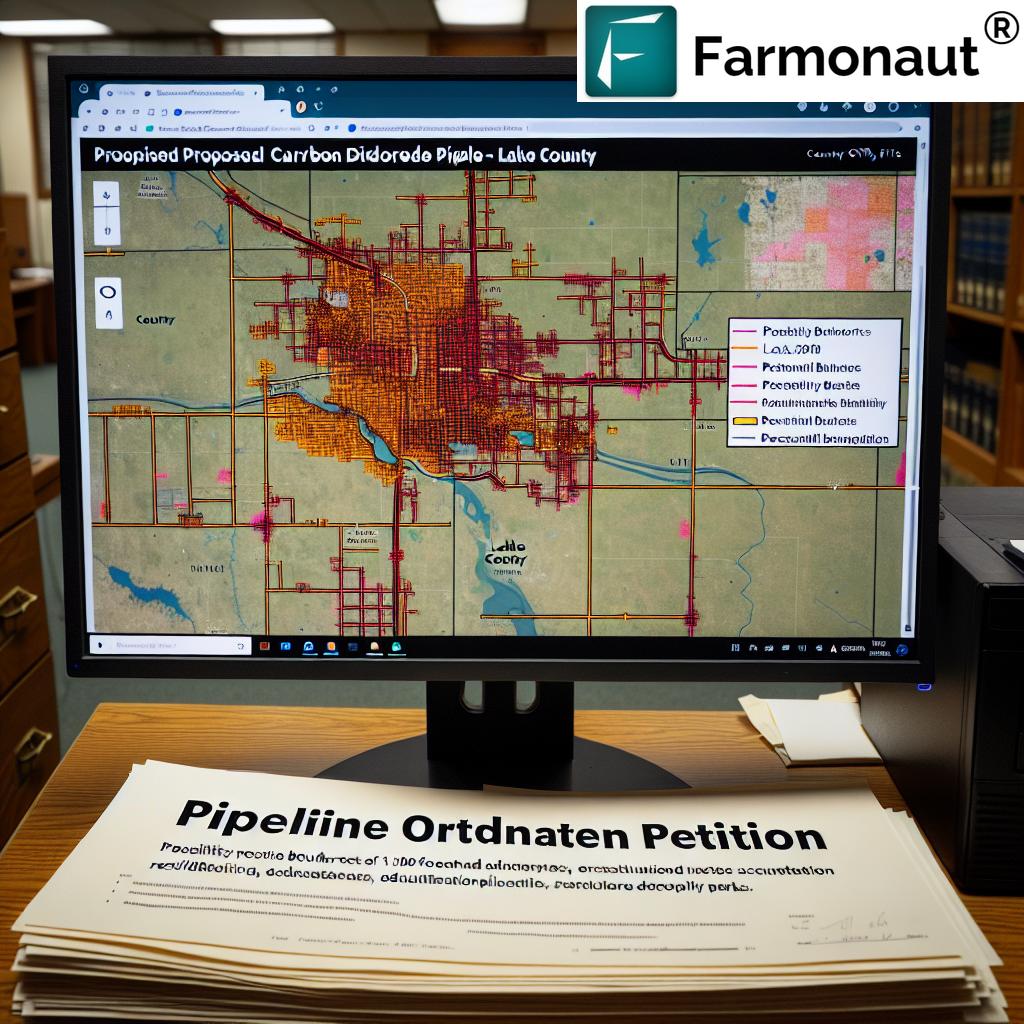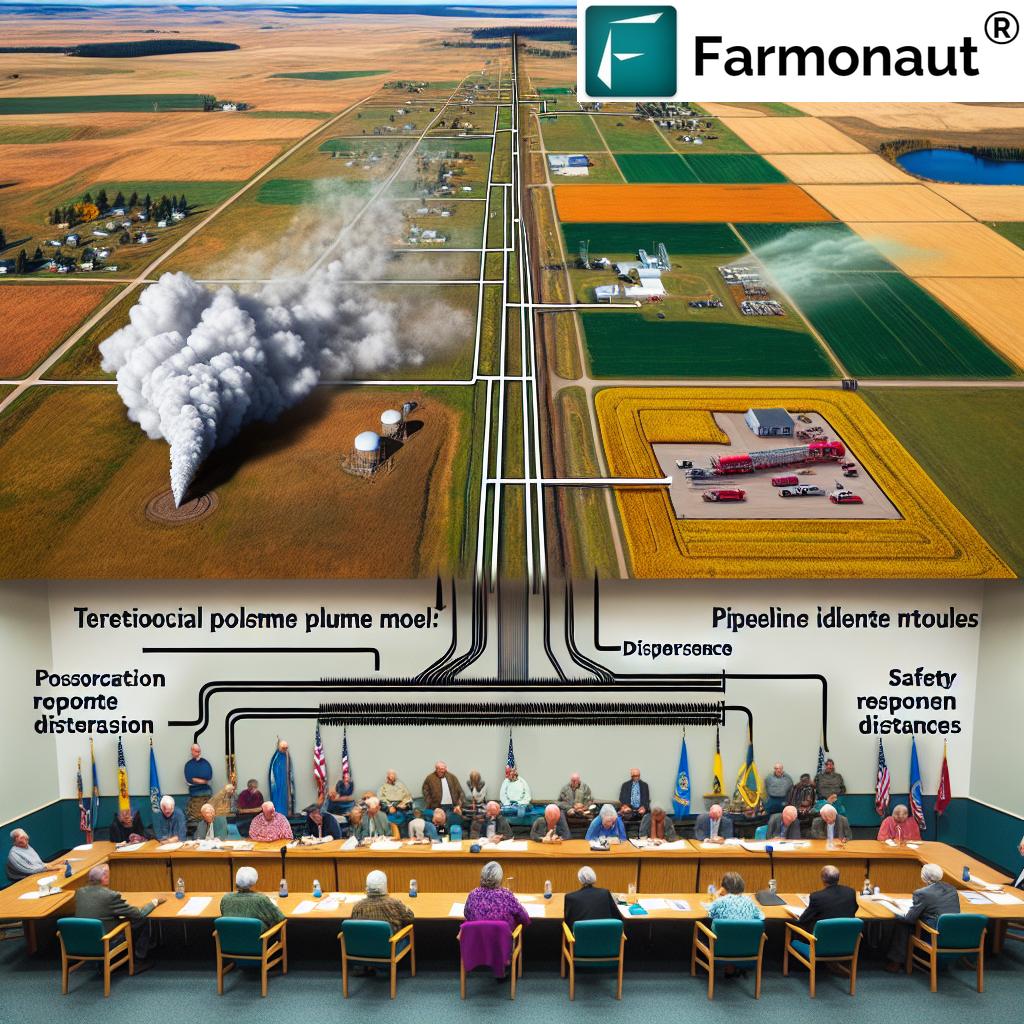South Dakota’s Carbon Dioxide Pipeline Ordinance: Local Control and Safety Measures Spark Citizen Petition in Lake County
“Lake County’s proposed CO2 pipeline ordinance requires a 1,500-foot setback from residences, schools, and parks.”
In the heart of South Dakota, a grassroots movement is taking shape that could redefine the landscape of carbon dioxide pipeline regulations. We, the citizens of Lake County, are witnessing a pivotal moment in local governance as a petition circulates to bring a carbon dioxide pipeline ordinance to a public vote. This initiative, spearheaded by the Lake County Citizens for Agriculture, Recreation, Environment and Stewardship (CARES), reflects a growing trend across the state where communities are asserting their right to local control over pipeline projects that could significantly impact their lives and livelihoods.
The Genesis of the Petition
For years, concerned citizens have approached the Lake County Commission, seeking a public discussion on pipeline regulations. However, their pleas have fallen on deaf ears. Aaron Johnson, a Madison area farmer and one of the driving forces behind the petition, explains, “We have gone before them repeatedly and asked them to have this discussion with the public, but they have refused to even talk to us about it.” This lack of engagement from local officials has catalyzed a movement that aims to put the power back into the hands of the people.
The proposed ordinance is not without precedent. Several counties in South Dakota have already taken proactive steps to regulate carbon dioxide pipelines within their jurisdictions. Moody, Minnehaha, Spink, Brown, McPherson, Edmunds, and Sanborn counties have all passed setback ordinances, setting a template for what Lake County citizens are now pursuing.
Key Components of the Proposed Ordinance
At its core, the Lake County carbon dioxide pipeline ordinance focuses on safety and local control. Here are the main provisions:
- Setback Distance: The ordinance mandates a 1,500-foot setback from homes, schools, and parks for carbon dioxide pipelines.
- Larger Pipeline Safety Measures: For pipelines exceeding 24 inches in diameter, the setback distance would be determined through computer plume modeling to ensure maximum safety.
- Emergency Response Planning: Pipeline companies would be required to provide a comprehensive emergency response plan.
- Equipment Provision: Applicants must propose a list of emergency equipment to be provided to county emergency services agencies.
- Landowner Flexibility: A waiver system allows property owners to opt-out of the setback requirement if they choose.
Johnson emphasizes the common-sense approach of the ordinance: “Currently, Lake County does not have any zoning ordinances on carbon dioxide pipelines, so they can put a pipeline very, very close to your residence if they wanted to. If your house is near the property line, they don’t need to use eminent domain, but you can still be negatively affected by the presence of that pipeline near your property line.”

The Importance of Local Control
The push for local control over pipeline projects is not unique to Lake County. It’s part of a broader movement across South Dakota and the nation, where communities are asserting their right to have a say in infrastructure projects that could significantly impact their way of life. Rita Brown, a long-time advocate in the pipeline battle from Chester, points out the overwhelming support for local control in Lake County:
“Nearly 65% of Lake county residents voted against RL 21,” Brown states, referring to a referendum on last November’s ballot that critics argued would have limited counties’ ability to establish setbacks for projects like carbon dioxide pipelines. “This petition seeks to put into law exactly what Lake County voted for: local control over setback distances.”
This desire for local control is not about outright opposition to pipeline projects. Rather, it’s about ensuring that these projects are developed in a way that respects the rights and safety of local residents. By establishing clear regulations at the county level, communities can work proactively with pipeline companies to address concerns and find mutually beneficial solutions.
The Petition Process and Next Steps
The petition drive in Lake County is ongoing, with organizers working tirelessly to gather the necessary signatures to initiate an ordinance according to South Dakota Codified Law 7-18A. Once the required number of signatures is obtained and verified by the County Auditor, the petition will be presented to the County Commission. At that point, the commission will have 60 days to set a date for a special election.
This process exemplifies grassroots democracy in action. It’s a reminder that in our system of government, citizens have the power to shape local laws and regulations. Johnson urges community involvement, saying, “We need your help to ensure this issue gets on the ballot so voters can have their say.”
Balancing Interests: Agriculture, Property Rights, and Infrastructure
The debate surrounding carbon dioxide pipeline ordinances touches on several critical issues that are of paramount importance to South Dakota communities:
- Agricultural Interests: As a predominantly agricultural state, South Dakota must consider how pipeline projects could impact farmland and agricultural operations.
- Property Rights: Landowners are concerned about how pipelines might affect their property values and their ability to use their land as they see fit.
- Infrastructure Development: There’s a recognition that infrastructure projects, including pipelines, can bring economic benefits to the region.
- Environmental Stewardship: Citizens are increasingly aware of the need to balance development with environmental protection.
The proposed ordinance seeks to strike a balance between these competing interests. By establishing clear setback distances and safety measures, it aims to protect property rights and ensure public safety while still allowing for infrastructure development.
Carbon Dioxide Pipelines: Understanding the Technology and Risks
To fully grasp the implications of the proposed ordinance, it’s crucial to understand the technology behind carbon dioxide pipelines and the potential risks they pose. Carbon dioxide pipelines are primarily used for carbon capture and storage (CCS) projects, which aim to reduce greenhouse gas emissions by capturing CO2 from industrial sources and transporting it to storage sites deep underground.
While these projects have the potential to play a significant role in mitigating climate change, they also come with inherent risks:
- Leaks and Ruptures: CO2 is heavier than air and can accumulate in low-lying areas, potentially causing asphyxiation.
- Corrosion: CO2 can form carbonic acid when mixed with water, leading to pipeline corrosion if not properly managed.
- Rapid Depressurization: In the event of a rupture, the rapid expansion of CO2 can cause extreme cooling, potentially damaging surrounding infrastructure.
These risks underscore the importance of proper safety measures and setback distances, as proposed in the Lake County ordinance. By implementing these precautions, communities can help mitigate potential hazards while still allowing for the development of this important technology.
“Several South Dakota counties have already passed similar pipeline ordinances, indicating a growing trend in local control.”
The Broader Impact: Setting a Precedent for Other Counties
The Lake County petition is not occurring in isolation. It’s part of a larger trend across South Dakota where counties are taking proactive steps to regulate carbon dioxide pipelines. This movement towards local control could have far-reaching implications:
- Standardization of Regulations: As more counties adopt similar ordinances, it could lead to a more standardized approach to pipeline regulation across the state.
- Increased Public Awareness: The petition process is educating citizens about the complexities of pipeline projects and their potential impacts on communities.
- Empowerment of Local Governments: Successful ordinances could embolden other counties to assert their authority on similar issues.
- Potential for State-Level Action: If enough counties adopt similar measures, it could prompt state legislators to consider statewide regulations.
The actions taken in Lake County and other South Dakota counties could serve as a model for communities across the nation grappling with similar issues. It demonstrates how local action can shape broader policy discussions and potentially influence state and federal regulations.

The Role of Technology in Pipeline Safety and Monitoring
As we discuss pipeline safety and regulations, it’s important to consider the role that advanced technology can play in monitoring and managing these infrastructure projects. While not directly related to the ordinance, technologies like those offered by Farmonaut’s crop plantation and forest advisory services demonstrate how satellite imagery and data analysis can be used to monitor large areas efficiently.
In the context of pipeline safety, similar technologies could potentially be employed to:
- Monitor pipeline corridors for unauthorized activities or encroachments
- Detect early signs of land subsidence or other geological changes that could affect pipeline integrity
- Assess the environmental impact of pipeline construction and operation
While these technologies are not a substitute for proper setback distances and safety regulations, they could complement regulatory efforts by providing additional layers of monitoring and safety assurance.
Emergency Preparedness and Response
One of the key components of the proposed Lake County ordinance is the requirement for pipeline companies to provide emergency response plans and equipment. This focus on emergency preparedness is crucial for ensuring community safety in the event of a pipeline incident.
Effective emergency response planning for carbon dioxide pipelines should include:
- Risk Assessment: Identifying potential hazards and vulnerable areas along the pipeline route
- Response Protocols: Clear procedures for detecting leaks, notifying authorities, and evacuating affected areas
- Training Programs: Regular training for local emergency responders on how to handle CO2-specific incidents
- Public Education: Informing residents about pipeline locations, potential risks, and what to do in an emergency
- Equipment Provision: Ensuring that specialized equipment for detecting and managing CO2 leaks is readily available
By mandating these emergency preparedness measures, the ordinance aims to ensure that local communities are equipped to handle potential pipeline incidents effectively.
Economic Considerations of Pipeline Projects
While safety and local control are at the forefront of the Lake County petition, it’s also important to consider the economic implications of carbon dioxide pipeline projects. These infrastructure developments can have significant economic impacts, both positive and negative:
Potential Benefits:
- Job creation during construction and ongoing maintenance
- Increased tax revenue for local governments
- Potential for attracting related industries to the area
Potential Drawbacks:
- Impact on property values for land near pipelines
- Potential disruption to agricultural operations during construction
- Long-term land use restrictions in pipeline corridors
The proposed ordinance seeks to balance these economic considerations with safety and property rights concerns. By establishing clear regulations, it aims to create a framework where pipeline projects can proceed in a manner that maximizes benefits to the community while minimizing potential negative impacts.
Environmental Stewardship and Carbon Capture
The debate surrounding carbon dioxide pipelines in South Dakota is intrinsically linked to broader discussions about environmental stewardship and climate change mitigation. Carbon capture and storage (CCS) technology, which these pipelines support, is seen by many as a crucial tool in reducing greenhouse gas emissions.
However, it’s important to consider both the potential benefits and drawbacks of CCS projects:
Potential Benefits:
- Significant reduction in CO2 emissions from industrial sources
- Potential to help meet climate change mitigation goals
- Possible utilization of captured CO2 for enhanced oil recovery or other industrial processes
Potential Drawbacks:
- High energy requirements for capture and compression of CO2
- Concerns about long-term storage safety and potential leakage
- Environmental impacts of pipeline construction and operation
The proposed Lake County ordinance doesn’t seek to prevent CCS projects outright but rather to ensure that they are implemented in a way that prioritizes community safety and environmental protection. This approach aligns with the broader goal of responsible environmental stewardship.
Comparison of Carbon Dioxide Pipeline Ordinances in South Dakota Counties
| County Name | Setback Distance (feet) | Safety Measures Required | Emergency Response Plan Mandates | Public Input Process | Date Enacted/Proposed |
|---|---|---|---|---|---|
| Lake County (Proposed) | 1,500 | Computer plume modeling for larger pipelines | Comprehensive plan required | Public petition and vote | Pending |
| Moody County | 1,000 | Regular inspections | Annual updates required | Public hearings held | 2022 |
| Minnehaha County | 1,320 | Advanced leak detection systems | Quarterly drills mandated | Task force established | 2023 |
| Spink County | 1,500 | Enhanced corrosion protection | Community notification system | Online feedback portal | 2022 |
| Brown County | 1,000 | Pressure monitoring stations | Joint exercises with local responders | Town hall meetings | 2023 |
This table provides a comparative overview of carbon dioxide pipeline ordinances across several South Dakota counties, including the proposed ordinance for Lake County. It highlights the variations in setback distances, safety measures, and public engagement processes, demonstrating the nuanced approaches different counties are taking to address this complex issue.
The Future of Pipeline Regulation in South Dakota
As we look to the future, the actions taken by Lake County and other South Dakota communities could shape the landscape of pipeline regulation for years to come. The grassroots movement for local control over pipeline projects reflects a broader trend of citizen engagement in complex policy issues.
Several factors could influence the future of pipeline regulation in the state:
- Legal Challenges: As more counties adopt pipeline ordinances, there may be legal challenges from pipeline companies or state authorities, potentially leading to court rulings that clarify the extent of local regulatory power.
- State Legislation: The proliferation of county-level ordinances could prompt state lawmakers to consider comprehensive statewide regulations for carbon dioxide pipelines.
- Technological Advancements: Improvements in pipeline safety technology and carbon capture methods could influence future regulatory approaches.
- Federal Policy: Changes in federal energy policy or environmental regulations could impact the development of carbon dioxide pipeline projects and related local ordinances.
Regardless of the outcome, the Lake County petition and similar efforts across South Dakota demonstrate the power of civic engagement and the importance of local voices in shaping infrastructure development. As we navigate the complex intersections of energy policy, environmental stewardship, and community safety, the lessons learned from these grassroots efforts will undoubtedly inform future policy discussions at all levels of government.
Conclusion: A Call for Informed Civic Engagement
The citizen-led petition for a carbon dioxide pipeline ordinance in Lake County, South Dakota, represents more than just a local regulatory effort. It’s a testament to the power of grassroots democracy and the importance of community involvement in shaping the policies that affect our daily lives.
As this process unfolds, we encourage all Lake County residents to:
- Educate themselves about the proposed ordinance and its potential impacts
- Engage in respectful dialogue with neighbors and local officials
- Participate in public meetings and forums on the issue
- Exercise their right to vote when the ordinance comes to the ballot
By taking an active role in this process, citizens can help ensure that any future pipeline projects in Lake County are developed in a manner that prioritizes community safety, respects property rights, and aligns with the values and needs of local residents.
As we navigate these complex issues, it’s clear that the outcome of this petition drive will have implications far beyond the borders of Lake County. It will serve as a model for how communities can assert their right to local control while engaging with broader regional and national infrastructure developments.
In the end, the success of this ordinance—and others like it across South Dakota—will depend on the active participation of informed citizens. It’s a reminder that in our democratic system, the power to shape our communities ultimately rests in the hands of the people.
FAQ Section
- Q: What is the main purpose of the proposed carbon dioxide pipeline ordinance in Lake County?
A: The main purpose is to establish local control over carbon dioxide pipeline projects, ensuring safety measures and setback distances that protect residents and property. - Q: How far must carbon dioxide pipelines be set back from residences, schools, and parks according to the proposed ordinance?
A: The ordinance requires a 1,500-foot setback from residences, schools, and parks. - Q: Can landowners opt-out of the setback requirement?
A: Yes, the ordinance includes a waiver system that allows property owners to opt-out of the setback requirement if they choose. - Q: What safety measures are required for larger pipelines?
A: For pipelines exceeding 24 inches in diameter, the setback distance would be determined through computer plume modeling to ensure maximum safety. - Q: How does this ordinance compare to regulations in other South Dakota counties?
A: Several other South Dakota counties have passed similar ordinances, with setback distances ranging from 1,000 to 1,500 feet. Lake County’s proposed ordinance is in line with these existing regulations. - Q: What is the process for getting this ordinance on the ballot?
A: Organizers are gathering signatures for a petition. Once enough signatures are collected and verified, the County Commission will have 60 days to set a date for a special election. - Q: How does this ordinance address emergency preparedness?
A: The ordinance requires pipeline companies to provide comprehensive emergency response plans and propose emergency equipment to be provided to county emergency services agencies. - Q: Will this ordinance prevent all pipeline projects in Lake County?
A: No, the ordinance doesn’t prevent pipeline projects outright. It establishes regulations to ensure such projects are developed safely and with consideration for local residents. - Q: How might this ordinance impact property values?
A: By establishing setback distances, the ordinance aims to mitigate potential negative impacts on property values that could result from pipelines being located too close to residences. - Q: What role does public input play in this process?
A: Public input is crucial. The petition process itself is a form of public input, and if the ordinance goes to a vote, it will be decided directly by the citizens of Lake County.
Earn With Farmonaut: Earn 20% recurring commission with Farmonaut’s affiliate program by sharing your promo code and helping farmers save 10%. Onboard 10 Elite farmers monthly to earn a minimum of $148,000 annually—start now and grow your income!
For those interested in learning more about advanced agricultural technologies that can complement community efforts in land management and environmental monitoring, consider exploring Farmonaut’s innovative solutions:
- Carbon Footprinting: Understand and manage carbon emissions in agricultural operations.
- Product Traceability: Ensure transparency and safety in agricultural supply chains.
- Crop Loan and Insurance: Access financial tools tailored for agricultural needs.
While these technologies are not directly related to pipeline regulations, they demonstrate the potential for innovative solutions in addressing complex agricultural and environmental challenges.
















